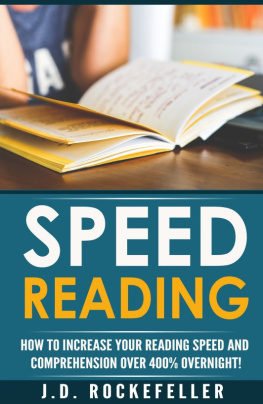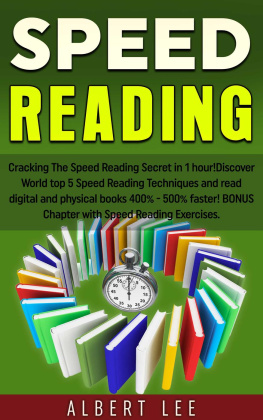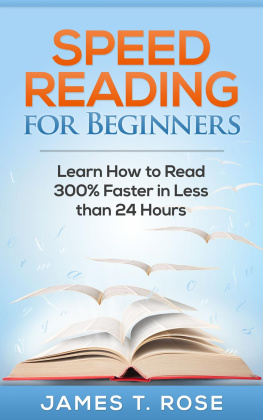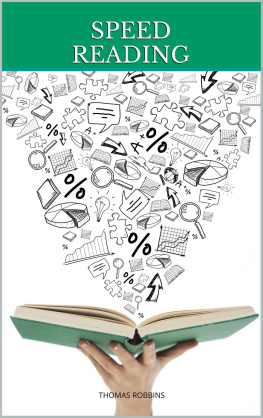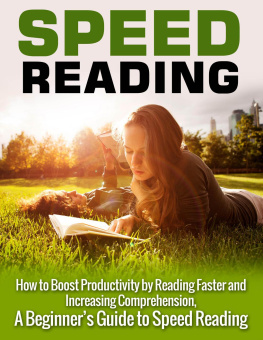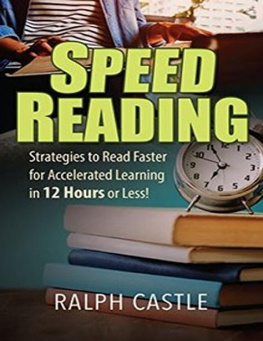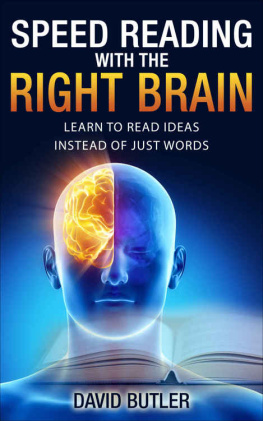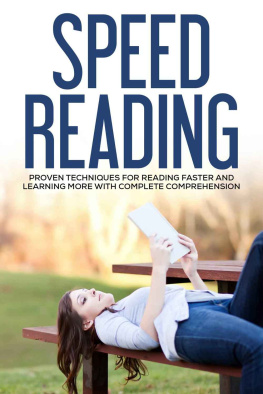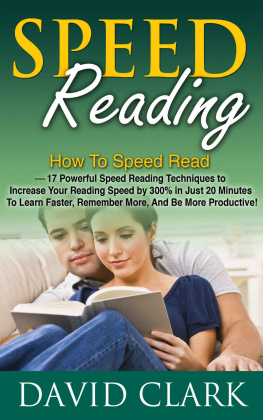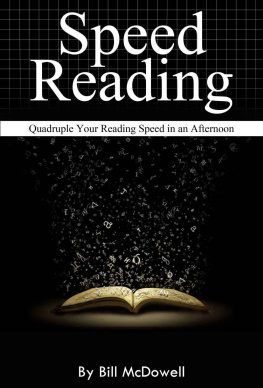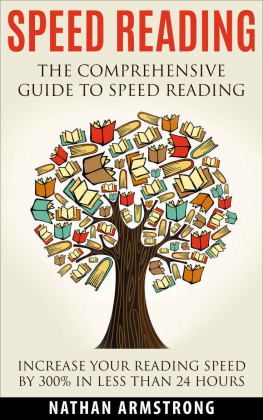Speed Reading
Dramatically Increase Your Reading Speed andComprehension Over 300% Overnight With These Quick and EasyHacks
J.D.ROCKEFELLER
Smashwords Edition
Copyright 2016 by J.D. Rockefeller
No part of this publication may bereproduced, distributed, or transmitted in any form or by anymeans, including photocopying, recording, or other electronic ormechanical methods, or by any information storage and retrievalsystem without the prior written permission of the publisher,except in the case of very brief quotations embodied in criticalreviews and certain other non-commercial uses permitted bycopyright law.
Table of Contents
Introduction
Speed reading canbe described as any of several methods used to improve your abilityto read faster. Both psychologists and educational experts workingon visual acuity concluded that, with a certain amount of training,an average individual could easily identify minute images displayedquickly on a screen for just one five-hundredth of a second. Thoughthe images that were used for the study were images of airplanes,the findings had implications on reading.
It wasn't until the later part of the 1950sthat a more portable, convenient, and reliable device was developedand used a tool for enhancing reading speed. Evelyn Wood, a schoolteacher and researcher at the time, was committed to understandingthe reason why some individuals were faster naturally at readingand even tried to make herself read quickly.
By 1958, while sweeping through pages of abook, she discovered that the brushing motion of her hands acrossthe pages caught her eye's attention and helped them move smoothlyacross each page. She used her hand as a pacer after realizingthis. Wood taught this method for the first time at UtahUniversity, before officially launching it as Evelyn Wood's ReadingDynamics in 1959.
Speed reading can also be described as askill honed with practice. Reading a text means comprehending thematerial, and in speed reading this is done through a number ofreading processes including overview, preview, read, review andrecite, read and recall (recording by writing a brief summary ormental outline) exercises.
Analyzing the Different Speed ReadingTechniques
Skimming
Skimming is a speed reading process thatinvolves visually searching or looking through the sentences on apage for hints and meaning. For some individuals, this style comesnaturally, although it is usually mastered by practice. Accordingto studies, skimming is practiced more by adults than children. Itis carried out at a higher rate (approximately 700 words per minuteor more) than the normal reading speed for comprehension (which isaround 200 to 230 words per minute), and it results in lessercomprehension rates, particularly when reading information-richmaterial.
Scanning
Scanning is a speed reading technique thatinvolves actively looking for information with a mind map(arranging information visually in a hierarchical manner showcasingthe interrelatedness of the material for better retrievability)created from skimming. These methods are practiced by meta-guidingthe eyes.
Meta Guiding
Meta guiding is a reading technique thatinvolves visually guiding the eye with a finger or pointer (like apen), as the eye moves faster with the length of each passage oftext. It also involves making invisible shapes on the page of thetext so as to widen the visual span, thereby making room for speedreading.
For example, a group of customers attending aspeed reading seminar are usually instructed to use one finger or apen to make shapes on a page. They are told that this speeds uptheir visual cortex, increases their visual span when it comes toabsorbing the whole line, and imprints information into theirsubconscious for retrieval at a later time.
Meta guiding is believed to reducesub-vocalization so as to speed up reading. Because it allows theeye to skim through the text, it reduces comprehension and memory,which may lead to missing vital details of the text. There must bemore emphasis on viewing every word (briefly) if this technique isto be effective.
SQ3R Process
Another important technique for bettercomprehension in speed reading is the SQ3R process. It can help anindividual retain a majority of the presented text from a piece ofreading material. Better focus in comprehension can be achievedthrough an improved reading process with better understanding ofthe topic in consideration.
In the following chapters we will learn thekeys to speed reading success, how to learn speed reading skills,benefits of speed reading, and how to elevate your comprehensionwhile increasing your reading speed, among a host of otherareas.
Chapter One
How to Learn SpeedReading
The world today is based on text. You won'tbe able to navigate through the internet without possessingarguably the most valuable skill (reading). It is absolutelyessential and highly valued in society. The more materials youread, the better your reading becomes, including your writing andspelling, as well as grammar. These three skills are closelyconnected. The main benefit here is that with excellent languageskills, you will sound intelligent, well-educated, and enlightenedwhether you are communicating via email, employment application, orvia the phone.
Some people read slowly to the point thatthey have difficulty organizing the whole idea in a text. And whenthe information on the material is split into numerous sentences orwords, the point of the passage is often lost. Studies have shownthat individuals who consciously read faster improve their abilityto comprehend. When your brain can assimilate the informationcontinuously, it becomes easier to understand the text.
You can start by analyzing your speed readingdifficulties. Look for the problems that slow people down. Look fora quiet, comfortable place to read. Start with an easy tounderstand material like a novel. Try to follow the words with apointing aid, like your finger, under each line you read. Choosinga spot with minimal distraction naturally helps to boost yourreading speed.
Try to watch your reading speed. Set a timefor yourself and fix an average of words for each minute when youread. If you are able to read only 200 words or less per minute,you are slow. If you are able to read 600 words or more per minutewhether you are skimming, scanning, or meta guiding, you are a fastreader. Studies have shown that fast readers are better when itcomes to studying, and they are more productive at work. Some fastreaders (with practice) are capable of covering 1,000+ words perminute, which in most cases is an entire page of the text.
Chapter Two
Speed Reading andComprehension
When using the normal reading technique(which on the average is between 200 to 400 words per minute), ourcomprehension of the material is almost 100%. But, on the otherhand, the idea of speed reading at twice the average pace has beenargued by many experts that comprehension of the material iscompromised. Although this line of thought may be true to somepoint, especially with individuals who only learned speed readingtechniques recently, comprehension usually improves given time.
Yes. It takes a great deal of time andregular practice to enhance comprehension. For a simple material,it is possible for a speed reader to have a higher comprehensionlevel. When it comes to a more complex text or an unfamiliarconcept, comprehension is compromised when reading more than 500words per minute. Getting rid of such techniques includingsub-vocalization also negatively or positively impacts yourcomprehension of a complex text.
The material you are reading can also impactyour comprehension. It is much easier to comprehend a novel withspeed reading as compared to a textbook or course material, whichoften requires greater concentration while reading. As you speedread, you may take in lots of information, but your brain'sprocessing capacity becomes limited and it might not be able tohandle all the information that is thrown at it, thus leading to acompromised ability to comprehend.

